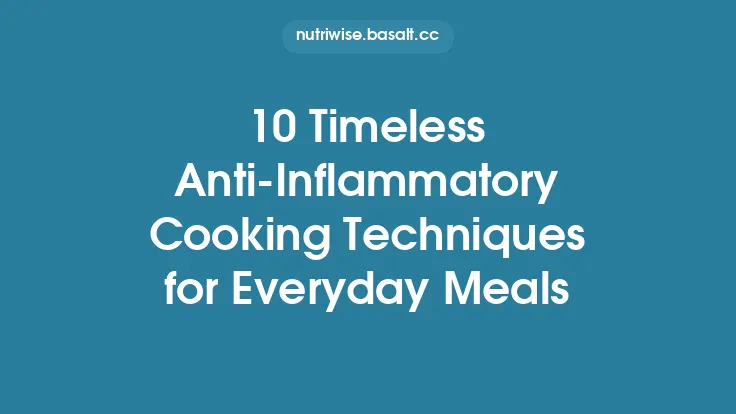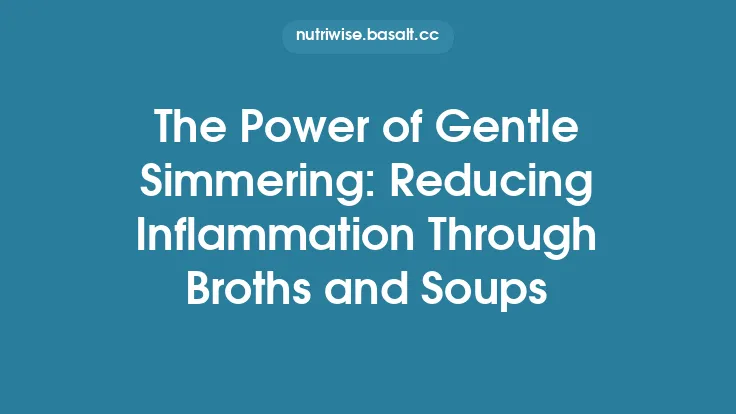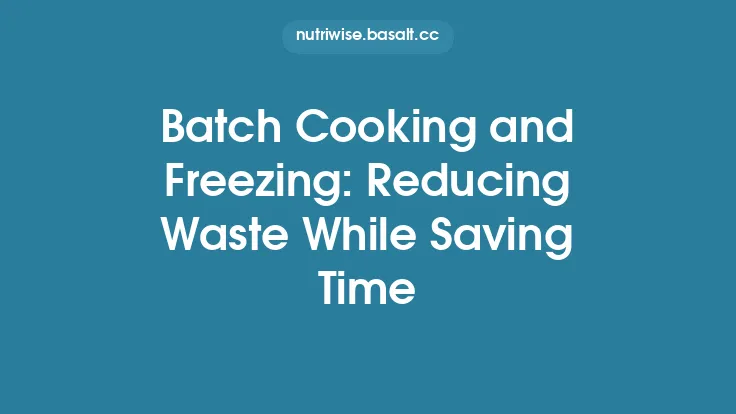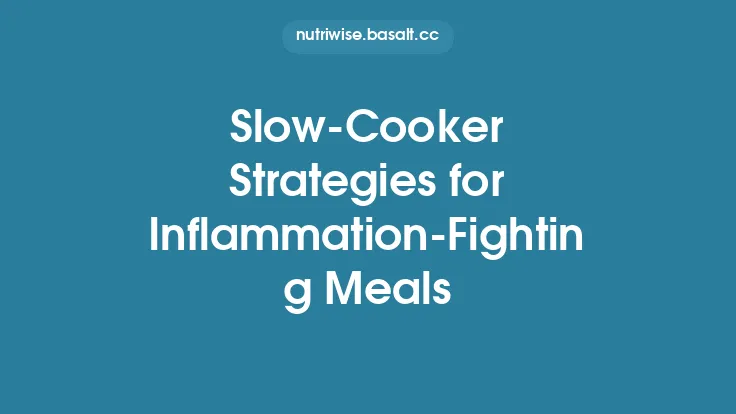One‑pot cooking has become a kitchen staple for busy families, health‑conscious professionals, and anyone looking to reduce cleanup without sacrificing flavor. When the goal is to combat chronic inflammation—a driver of conditions ranging from arthritis to cardiovascular disease—the one‑pot approach offers a unique blend of convenience and nutritional power. By consolidating ingredients, cooking liquids, and spices in a single vessel, you can preserve heat‑sensitive phytochemicals, maximize the synergistic effects of anti‑inflammatory compounds, and create meals that are both satisfying and supportive of long‑term health.
Why One‑Pot Meals Are Naturally Anti‑Inflammatory
1. Retention of Water‑Soluble Phytochemicals
Many anti‑inflammatory compounds, such as flavonoids (quercetin, kaempferol) and certain polyphenols, are water‑soluble. When vegetables are simmered together with broth or water, these molecules leach into the cooking liquid rather than being discarded. The resulting broth becomes a nutrient‑dense carrier, delivering antioxidants directly to the palate and the body.
2. Enhanced Bioavailability Through Synergy
Cooking foods together can increase the bioavailability of certain nutrients. For example, the fat‑soluble curcumin in turmeric is better absorbed when paired with a modest amount of healthy oil and black pepper (piperine). A one‑pot dish that includes turmeric, a drizzle of extra‑virgin olive oil, and a pinch of pepper creates a natural absorption matrix, amplifying curcumin’s anti‑inflammatory impact.
3. Reduced Oxidative Stress from Minimal Handling
Every time ingredients are cut, transferred, or exposed to air, oxidative enzymes can begin to degrade sensitive nutrients. By limiting the number of steps—prepping, cooking, and serving in the same pot—you minimize oxidation, preserving the integrity of vitamins C and E, as well as delicate polyphenols.
4. Balanced Macronutrient Profiles
One‑pot recipes often combine protein, complex carbohydrates, and healthy fats in a single bowl. This balance helps regulate blood glucose spikes, which are known to trigger inflammatory pathways via advanced glycation end products (AGEs). A well‑designed one‑pot meal can therefore act as a metabolic stabilizer.
Choosing the Right Vessel
The type of pot you use influences heat distribution, moisture retention, and the final texture of the dish.
| Vessel | Heat Conductivity | Ideal Uses | Anti‑Inflammatory Considerations |
|---|---|---|---|
| Stainless Steel (Heavy‑Bottomed) | Excellent, especially with an aluminum or copper core | Searing, deglazing, simmering | Non‑reactive, preserves flavor of acidic ingredients (tomatoes, citrus) without leaching metals. |
| Cast Iron (Enameled) | Even, retains heat for long periods | Braising, slow simmer | Provides a small amount of iron, beneficial for those with low ferritin, but ensure the enamel is intact to avoid rust. |
| Ceramic (Dutch‑style) | Uniform heat, excellent moisture lock | Stews, soups, rice dishes | Naturally non‑reactive; retains heat without additional oil, supporting low‑fat cooking. |
| Pressure Cooker / Instant Pot | Rapid pressure cooking, high temperature | Quick braising, beans, whole grains | Shortens cooking time, preserving heat‑sensitive antioxidants; be mindful of over‑cooking delicate vegetables. |
Core Anti‑Inflammatory Ingredients for One‑Pot Meals
- Omega‑3‑Rich Proteins
- Fatty fish (salmon, sardines)
- Shellfish (mussels, shrimp)
- Plant‑based options (chia, hemp seeds added at the end)
- Phytonutrient‑Dense Vegetables
- Dark leafy greens (kale, Swiss chard) – high in lutein and zeaxanthin.
- Cruciferous vegetables (broccoli, cauliflower) – contain sulforaphane, a potent Nrf2 activator.
- Brightly colored produce (red bell peppers, carrots, beets) – rich in carotenoids and betalains.
- Spice Arsenal
- Turmeric (curcumin) – anti‑inflammatory, antioxidant.
- Ginger – inhibits COX‑2 enzyme activity.
- Cinnamon – stabilizes blood sugar, reduces cytokine production.
- Garlic – allicin boosts immune modulation.
- Healthy Fats
- Extra‑virgin olive oil (polyphenol‑rich) – best added early for flavor infusion.
- Avocado oil (high smoke point) – suitable for brief sauté steps before adding liquids.
- Nuts & seeds (walnuts, pumpkin seeds) – sprinkle at serving for texture and omega‑3 boost.
- Acidic Enhancers
- Lemon or lime juice – improves iron absorption from plant foods.
- Apple cider vinegar – may aid digestion and lower glycemic response.
Building a One‑Pot Anti‑Inflammatory Meal: Step‑by‑Step Framework
Step 1: Layer Flavors Early
Begin by heating a modest amount of olive oil in the pot. Add aromatics such as minced garlic, ginger, and onion. Sauté just until fragrant (30–45 seconds) to release volatile compounds without browning them excessively, which could generate unwanted Maillard products.
Step 2: Introduce Protein and Spice
Add your protein source. For fish, sear briefly on each side to develop a light crust; for legumes, simply stir them in. Sprinkle ground turmeric, cumin, and a pinch of black pepper at this stage. The oil acts as a carrier for fat‑soluble curcumin, while pepper’s piperine inhibits hepatic glucuronidation, extending curcumin’s half‑life.
Step 3: Add Bulk Vegetables and Liquid
Incorporate chopped cruciferous vegetables, leafy greens, and root vegetables. Pour in a low‑sodium broth or filtered water—enough to just cover the ingredients. The liquid will become a nutrient‑rich broth as the vegetables release their phytochemicals.
Step 4: Simmer Gently
Bring the mixture to a low boil, then reduce to a gentle simmer. Cover the pot to trap steam, which helps preserve water‑soluble vitamins (C, B‑complex). Simmer for 15–30 minutes, depending on the protein and vegetable hardness. Avoid vigorous boiling, which can degrade delicate antioxidants.
Step 5: Finish with Fresh Elements
Just before serving, stir in a splash of citrus juice, a handful of fresh herbs (parsley, cilantro), and a drizzle of cold‑pressed flaxseed oil if you desire extra omega‑3s. This final addition preserves the integrity of heat‑sensitive nutrients and adds a bright flavor contrast.
Step 6: Serve and Store
Ladle the stew into bowls, ensuring each serving receives a balanced mix of protein, vegetables, and broth. Cool leftovers rapidly (within two hours) and store in airtight containers in the refrigerator for up to four days. Reheat gently on the stovetop or in a microwave at medium power to avoid overheating the anti‑inflammatory compounds.
Nutrient Preservation Tips Specific to One‑Pot Cooking
- Temperature Control: Keep the simmer temperature between 85–95 °C (185–203 °F). This range is hot enough to break down connective tissue in proteins but low enough to protect most polyphenols.
- Timing of Add‑Ins: Add highly heat‑sensitive ingredients (e.g., fresh herbs, leafy greens, citrus zest) in the last 5 minutes of cooking or after the pot is removed from heat.
- Acid‑Base Balance: A modest amount of acid (vinegar or lemon) can stabilize anthocyanins in red cabbage and berries, preserving their deep color and antioxidant capacity.
- Avoid Over‑Cooking Starches: If using whole grains (brown rice, quinoa), pre‑soak them to reduce cooking time, preventing excessive leaching of B‑vitamins into the broth.
Sample One‑Pot Anti‑Inflammatory Recipes
1. Mediterranean Turmeric‑Fish Stew
- Protein: 400 g wild‑caught salmon, cut into chunks
- Vegetables: 1 cup chopped kale, 1 cup diced tomatoes, ½ cup sliced zucchini
- Spices: 1 tsp ground turmeric, ½ tsp smoked paprika, ¼ tsp black pepper
- Liquids: 3 cups low‑sodium fish broth, ½ cup water
- Finishing Touch: 1 tbsp extra‑virgin olive oil, juice of ½ lemon, fresh dill
2. Hearty Lentil‑And‑Root Vegetable Pot
- Protein: 1 cup green lentils (pre‑rinsed)
- Vegetables: 1 cup diced carrots, 1 cup cubed sweet potatoes, ½ cup chopped Brussels sprouts
- Spices: 1 tsp ground ginger, ½ tsp cinnamon, ¼ tsp cayenne (optional)
- Liquids: 4 cups vegetable broth, 1 cup water
- Finishing Touch: 2 tbsp toasted pumpkin seeds, drizzle of avocado oil, sprinkle of parsley
3. Coconut‑Curried Shrimp & Quinoa Bowl
- Protein: 300 g peeled shrimp, deveined
- Vegetables: 1 cup sliced bell peppers (mixed colors), ½ cup snap peas, ½ cup shredded red cabbage
- Spices: 1 tsp curry powder (turmeric‑rich), ½ tsp ground coriander, pinch of sea salt
- Liquids: 2 cups coconut milk (light), 1 cup water, ½ cup quinoa (rinsed)
- Finishing Touch: 1 tbsp lime juice, handful of cilantro, toasted coconut flakes
Integrating One‑Pot Cooking Into a Lifestyle
- Meal Planning: Design a weekly menu around a core set of anti‑inflammatory staples (e.g., salmon, lentils, leafy greens). Rotate the vegetables and spices to keep flavors fresh while maintaining nutrient consistency.
- Batch Cooking: While the article avoids “batch‑prep” as a separate technique, you can still prepare multiple one‑pot meals in a single day, storing each in its own container. This approach respects the one‑pot philosophy—each dish remains self‑contained—while providing convenience.
- Mindful Eating: Serve meals at a moderate temperature (around 55–60 °C/130–140 °F) to enjoy the full spectrum of flavors and aromas, which can enhance satiety and reduce the tendency to over‑eat, indirectly supporting anti‑inflammatory goals.
Potential Pitfalls and How to Avoid Them
| Issue | Why It Matters | Solution |
|---|---|---|
| Excessive Salt | High sodium can promote endothelial inflammation. | Use low‑sodium broths, herbs, and spices for flavor instead of salt. |
| Over‑Cooking Greens | Prolonged heat can degrade chlorophyll and vitamin K. | Add leafy greens in the final 5 minutes of simmering. |
| Insufficient Healthy Fat | Fat‑soluble anti‑inflammatory compounds need a lipid medium for absorption. | Include at least 1–2 teaspoons of olive or avocado oil per pot. |
| Using Reactive Cookware | Aluminum or uncoated cast iron can leach metals, potentially interacting with acidic foods. | Stick to stainless steel, enameled cast iron, or high‑quality ceramic pots. |
| Neglecting Portion Control | Even anti‑inflammatory foods can contribute to excess calories if portions are too large. | Aim for a balanced plate: ½ vegetables, ¼ protein, ¼ whole grains or starchy veg. |
The Science Behind One‑Pot Synergy
Recent studies in nutritional biochemistry have highlighted the concept of food matrix interactions, where the physical and chemical environment of a meal influences nutrient bioavailability. In a one‑pot setting:
- Emulsification: The gentle agitation of oil and water during the initial sauté creates micro‑emulsions that encapsulate lipophilic compounds (e.g., curcumin, carotenoids), facilitating their transport across the intestinal wall.
- Complexation: Polyphenols can bind to proteins and fibers released during cooking, forming complexes that protect them from oxidative degradation in the gut.
- Fermentation Potential: When legumes and whole grains are cooked together, residual oligosaccharides can serve as prebiotic substrates for gut microbiota, leading to the production of short‑chain fatty acids (SCFAs) that have systemic anti‑inflammatory effects.
Understanding these mechanisms underscores why a single pot, where ingredients co‑cook and interact, can be more than the sum of its parts.
Final Thoughts
One‑pot anti‑inflammatory cooking marries convenience with science. By selecting the right vessel, layering flavors strategically, and respecting the delicate balance of heat, moisture, and healthy fats, you can craft meals that not only simplify your kitchen routine but also deliver a potent arsenal of nutrients aimed at reducing chronic inflammation. Embrace the versatility of this technique—whether you’re preparing a quick weekday dinner or a nourishing weekend stew—and let each pot become a cornerstone of a healthier, less inflamed life.





